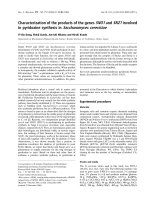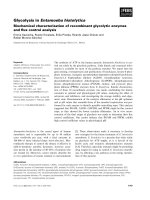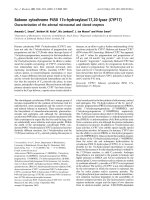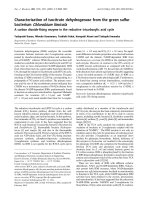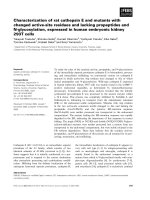Characterization of liver x receptor and retinoid acid receptor mediated response with transcriptome and histological analysis in zebrafish liver
Bạn đang xem bản rút gọn của tài liệu. Xem và tải ngay bản đầy đủ của tài liệu tại đây (2.6 MB, 105 trang )
CHARACTERIZATION OF LIVER X RECEPTOR- AND
RETINOID ACID RECEPTOR-MEDIATED RESPONSE
WITH TRANSCRIPTOMIC AND HISTOLOGICAL
ANALYSIS IN ZEBRAFISH LIVER
HENDRIAN SUKARDI
B.Sc. (Honors), U of T
A THESIS SUBMITTED FOR THE DEGREE OF MASTER
OF SCIENCE
DEPARTMENT OF BIOLOGICAL SCIENCES
NATIONAL UNIVERSITY OF SINGAPORE
2010
CHARACTERIZATION OF LIVER X RECEPTOR- AND
RETINOID ACID RECEPTOR-MEDIATED RESPONSE
WITH TRANSCRIPTOME AND HISTOLOGICAL
ANALYSIS IN ZEBRAFISH LIVER
HENDRIAN SUKARDI
NATIONAL UNIVERSITY OF SINGAPORE
2010
Acknowledgements
I would like to thank to my supervisors, Professor Gong Zhiyuan and Dr. Lam Siew
Hong, who have been supportive and helpful in providing me guidance throughout my
graduate studies. Professor Gong offered me a valuable opportunity to do graduate study
in his lab. Dr Lam Siew Hong provided me a lot of guidance and training to be a critical
thinker and a good scientist.
I would like to give special thanks to Myintzu Hlaing, Zhan Huiqing and Svitlana Korzh
whom I have bothered a lot and have provided me lots of assistance and guidance on
benchwork. I learnt a lot of benchwork skills from them and they helped me in some of
my experiments, and I would probably not been able to accomplish much lab results
without them.
I also would like to thank my labmates who also helped me in my experiments and
making the lab a nice place to be in: Grace, Li Zhen, Xu Dan, Preethi, Hongyan, Li Yan,
Balang, Choong Yong, Yin Ao, Caixia, Grace, Tina, Weiling, Zhou Li, Lili and other
labmates.
In addition, I would like to thank my family and friends for supporting me throughout the
research. I would also like to give special thanks to Albert Goedbloed, Hendrick Sukardi,
Henry Sukardi (Butok), Zhan Huiqing, Nicholas Karl Romanidis and Yevgeniy Igorovich
Nikitin (Jenya) for providing moral and emotional support when I greatly needed them
throughout my studies. People come and go, but real good friends remain together.
I dedicate this thesis to my former, but special, biochemistry teacher, Professor Emeritus
Robert Kincaid Murray.
To Monty python group, who never cease to make me wonder whether a swallow can
carry a coconut? If it can, is it an African or European swallow?
i
Table of Contents
Acknowledgements
i
Table of Contents
ii
Summary
iv
List of Tables
v
List of Figures
vi
Chapter 1 Introduction
1
1.1
1.2
2
2
1.3
1.4
Zebrafish as an attractive model for vertebrate development studies
Zebrafish as an emerging model for toxicology and chemical biology
using omics
1.2.1 Mechanistic omics
1.2.2 Comparative omics application with repository databank
1.2.3 Transcriptomic approaches in chemical perturbation studies in
zebrafish
1.2.4 Transcriptomics
Nuclear Receptors
1.3.1 Liver X receptor
1.3.2 Retinoic acid receptor
Main objectives and significance of the study
Chapter 2 Materials and Methods
2.1
2.2
2.3
2.4
2.5
4
8
9
10
13
14
15
16
18
The zebrafish
19
T0901317 and all-trans retinoic acid treatment
19
Microarray experiments and transcriptome analysis with
20
knowledge-based analysis
2.3.1 RNA extraction and DNA microarray experiments
20
2.3.2 Microarray data normalization and transcriptome analysis
21
2.3.3 Transcriptome profile analysis with Gene Set Enrichment Analysis 22
(GSEA)
2.3.4 Ingenuity Pathway Analysis
23
Gene validation with real time quantitative PCR
23
Histological processing and analysis
25
2.5.1 Histological processing, sectioning, and hematoxylin and eosin
25
staining
2.5.2 ApopTag staining
25
2.5.3 Periodic acid-Schiff (PAS) staining
26
2.5.4 Oil Red O staining
26
2.5.5 Histological examination
26
ii
Results and Discussion
Chapter 3 Transcriptomic response to liver X receptor (LXR)
agonist T0901317 in zebrafish liver
28
3.1
29
3.2
3.3
3.4
Histological analysis of T0901317-induced effects and toxicity in
zebrafish liver
Microarray experiment and knowledge-based analysis of T0901317
treatment
3.2.1 Trancriptome analysis of T0901317-induced liver responses with
Gene Set Enrichment Analysis
3.2.1.1 Cellular Morphology and Adhesion
3.2.1.2 Coagulation and complement systems
3.2.1.3 Cellular toxicity and stress-induced Reponses
3.2.1.4 Diabetes and Beta-oxidation of Fatty Acids
3.2.2 Insights from Biological Network Analysis
Validation of gene expression via quantitative real-time PCR
Conclusion
32
32
35
36
40
40
44
49
50
Chapter 4 Transcriptomic response to retinoic acid receptor
52
(RAR) agonist all-trans retinoic acid in zebrafish liver
4.1
4.2
4.3
4.4
4.5
Histological analysis of all-trans retinoic acid-treated liver
Microarray experiment and knowledge-based analysis of
all-trans-retinoic treatment
4.2.1 Microarray experiment and data normalization
4.2.2 Cytoskeletal assembly and reorganization
4.2.3 Oxidative phosphorylation & oxidative stress-induced responses
4.2.4 Cell death
4.2.5 Protein and fat metabolism
4.2.6 Immune responses
Conserved response between all-trans retinoic acid-treated mouse
embryoid bodies and zebrafish
Validation of marker genes associated with canonical pathways
Conclusion
53
56
56
59
62
64
64
66
67
70
74
Chapter 5 Major conclusions and future directions
75
5.1
Major conclusions
76
5.2
Future directions
78
References
81
iii
Summary
Nuclear receptor, a class of ligand-activated transcription factor, regulates many
important physiological processes. Therefore nuclear receptors, such as liver x receptor
(LXR) and retinoic acid receptor (RAR), are attractive therapeutic targets. Although the
zebrafish is a prominent vertebrate model that has recently gained surging interest for
disease modeling and drug screening, currently little is known with regards to LXR- and
RAR-induced responses in zebrafish liver. In our efforts to investigate the potential of
zebrafish as a model for LXR- and RAR-related studies, we performed experiments using
adult male zebrafish exposed to all-trans retinoic acid (RAR agonist) or T0901317 (LXR
agonist) for 96 hours before sampling the liver for histological, transcriptomic and realtime PCR analyses. We observed LXR and RAR activation modulate several biological
processes involved in immune system and metabolic processes. Our transcriptomic
analysis corroborated with our histological analysis and real-time PCR analysis. We were
able to capture known effects of LXR and RAR activation as reported in mammalian
models, suggesting conserved mode-of-actions between mammals and fish. Our findings
indicate that zebrafish is a valid model for investigating LXR and RAR drug targets,
LXR- and RAR-mediated disruptions and metabolic disorders.
iv
List of Tables
Table No.
Title of Table
Page
1.
Primers used for validating T0901317 treatment
24
2.
Primers used for validating all-trans retinoic acid treatment
24
3.
Quantitative real-time PCR validation for selected genes
in T0901317 treatment
48
4.
Quantitative real-time PCR validation for selected genes in
all-trans retinoic acid treatment.
61
v
List of Figures
Figure No.
1.
Title of Figure
Hepatotoxicity induced by T0901317.
Page
31
2.
Gene Set Enrichment Analysis (GSEA) of liver transcriptome of
T0901317-treated zebrafish.
34
3.
Gene set enrichment analysis (GSEA) of the dose-dependent
transcriptional suppression by T0901317 treatment on
complement and coagulation cascade pathway.
38-39
4.
Gene network analysis of liver X receptor activation for
biological inferences.
43
5.
Hepatoxicity induced by all-trans retinoic acid (ATRA)
55
6.
Gene Set Enrichment Analysis (GSEA) of liver transcriptome
upon exposure to all-trans retinoic acid.
58
7.
Comparative transcriptome analyses between zebrafish livers
and mouse embryoid bodies upon exposure to all-trans retinoic
acid (ATRA) using Gene Set Enrichment Analysis (GSEA).
69
vi
List of Abbreviation
22R-HC
22-R-hydroxycholesterol
acads
acyl-Coenzyme A dehydrogenase, short chain
aco2
aconitase 2, mitochondrial
acta2
actin, alpha 2, smooth muscle, aorta
ACTB
beta-actin
Anti-DIG
anti-digoxigenin antibody
arg2
arginase, type II
Arp
actin related protein
arpc1a
actin related protein 2/3 complex, subunit 1A
atp5h
ATP synthase, H+ transporting, mitochondrial F0 complex, subunit d
ATRA
All-trans retinoic acid
BCIP
5-Bromo-4-chloro-3-indolyl phosphate
BCR
B cell antigen receptor
BPA
bisphenol
c8a
complement component 8, alpha polypeptide
c9
complement component 9
casp7
caspase 7
casp8
caspase 8
cox10
heme A: farnesyltransferase (yeast)
cryabb
crystallin, alpha B, b
cyp26a1
cytochrome P450, family 26, subfamily a, polypeptide 1
dlst
dihydrolipoamide S-succinyltransferase (E2 component of 2-oxo-glutarate
complex)
vii
dlst
dihydrolipoyllysine-residue succinyltransferase component of
2-oxoglutarate dehydrogenase complex, mitochondrial
f10
coagulation factor X
fasn-like
fatty acid synthase-like
FDR
false discovery rate
fos
V-fos FBJ murine osteosarcoma viral oncogene homolog
g6pca
glucose-6-phosphatase a, catalytic
gclc
glutamate-cysteine ligase catalytic subunit
GSEA
Gene Set Enrichment Analyses
H&E
hematoxylin and eosin
HDAC
histone deacetylase
Hh
Hedgehog
hnf1ba
HNF1 homeobox Ba
IACUC
Institutional Animal Care and Use Committee
igf1
insulin-like growth factor 1
IL-2
interleukin-2
ins
insulin
itga9
integrin, alpha 9 homolog
jun
V-jun sarcoma virus 17 oncogene homolog (avian)
LMH
Low, Mid and High
LOC563884
transforming growth factor beta 1-like
LXR
liver X receptor
mlh1
mutL homolog 1, colon cancer, nonpolyposis type 2 (E. coli)
viii
mmp9
matrix metallopeptidase 9
MMPs
Matrix Metalloproteinases
MODY
Maturity onset Diabetes of the Young
MSigDB
Molecular Signatures Database
NBT
Nitroblue tetrazolium
ndrg1
myc downstream regulated gene 1
NES
normalized enrichment scores
NRF2
Nuclear factor erythroid 2-like factor 2
OST
olfactory signal transduction
plg
plasminogen
pros1
protein S (alpha) homolog
psma3
proteasome (prosome, macropain) subunit, alpha type, 3
RAR
retinoic acid receptor
rel
reticuloendotheliosis viral oncogene homolog
ROS
reactive oxygen species
rpl13a
60S ribosomal protein L13a
slc25a27
protein kinase, solute carrier family 25, member 27
SMRT
silencing mediator of retinoic acid and thyroid hormone receptor
spp1 homolog secreted phosphoprotein 1 homolog
TCA
Tricarboxylic acid
TF
tissue factor
TGF- ß
Transforming growth factor ß
vcam1
vascular cell adhesion molecule 1
ix
VPA
valproic acid
x
Chapter 1
Introduction
1
1.1
Zebrafish as an attractive model for vertebrate development
studies
The zebrafish (Danio rerio) is a small freshwater tropical fish that is endemic to northern
India. Since early 1970s, George Streisinger and his colleagues have characterized the
use of zebrafish as a model organism for embryogenesis (Sreisinger et al., 1981; Detrich
et al., 1999), and it has recently become a popular model organism for studying
vertebrate development and gene function. They complement higher experimental
vertebrate models, such as rats and mice, due to its numerous innate advantages. First,
female zebrafish produce large clutches (100-200) of embryos per week. Secondly, the
zebrafish has fast embryonic development, whereby cleavage divisions, gastrulation,
morphogenesis, and organogenesis occur within 24 hours, and zebrafish embryos develop
into larvae in less than three days. Thirdly, the embryos are large, transparent and
develop externally to the mother. Thus taken all above, these attributes greatly facilitates
experimental observation and manipulation using zebrafish.
1.2
Zebrafish as an emerging model for toxicology and chemical
biology using omics
The zebrafish is an attractive lower vertebrate model for energy metabolism (Schlegel
and Stainier, 2007) and immune studies (Sullivan and Kim, 2008), since it shares many
similar important physiological attributes with mammals (Schlegel and Stainier, 2007).
The zebrafish has long been used as an experimental model to study chemical toxicity
2
ranging from mutagens, carcinogens, teratogens to direct toxicants since 1950s (Laale,
1977). From 1980s to mid-90s the zebrafish became a premier vertebrate developmental
and genetic model, and within the next decade it has positioned itself as a biomedical
model for various human disorders that could aid in discovering novel therapeutics.
Several recent studies, including ours, have shown conserved chemical-induced
organ/tissue responses between zebrafish and humans (Parng et al., 2002; Peterson et al.,
2004; Hill et al., 2005; Lam et al., 2006; Lieschke and Currie, 2007; Lam et al., 2008;
Tilton et al., 2008; Webb et al., 2009). Furthermore, there are recent surging interests in
using zebrafish for disease modeling, drug-induced perturbations and drug screening
(Stern and Zon, 2003; Zon and Peterson, 2005). Moreover, the zebrafish is small,
available in large numbers and maintained at lower husbandry cost than rodents. Thus
zebrafish can complement as a more cost-effective model to rodent in drug
characterization studies.
The zebrafish is amenable to various molecular techniques, and a large and increasing
number of mutant and transgenic lines available for modeling human diseases have added
further value to the system. Recently, the availability of vast genomic resources in
zebrafish and the ability to map zebrafish genes to mammalian homologs make it feasible
to apply omics approaches to chemical biology for identifying molecular biomarkers and
providing mechanistic insights into biological responses during chemical perturbation
and subsequently potential health-risk inferences to humans (Parng et al., 2002; Peterson
et al., 2004; Hill et al., 2005; Lieschke and Currie, 2007).
3
Omics approaches involve high-throughput technologies that allow characterization of
chemical-induced perturbations from the measurement of global changes in the
abundance of mRNA transcripts (transcriptome), proteins (proteome), and other
biomolecular components (metabolome) in complex biological systems. They have
revolutionized research in drug development and toxicology (Butcher et al., 2004; Harrill
and Rusyn, 2008; Blomme et al., 2009). By capturing the global profile of the biological
responses, investigation into the mode of action and toxicity of a chemical can be
facilitated. Furthermore, an omics database of chemicals can establish to help predict
pharmacological efficacy and toxicological effects of a new chemical and to improve the
selection of drug candidate (Ganter et al., 2005).
1.2.1
Mechanistic omics
With appropriate experimental design, omics data can provide mechanistic information
about the mode of action and toxicity of a chemical via knowledge-based data mining to
identify pathways and biological processes associated with the chemical perturbation. By
coupling traditional phenotypic endpoints with omics data, the mechanism of chemical
action and toxicity can be defined in a conceptual framework of cause-and-effect with
supports from known molecular interactions and phenotypic anchoring (Paules, 2003). In
one early study in rats, mechanistic action of estrogen induction of uterine growth and
maturation has been defined by linking differentially expressed gene sets and associated
biological processes to physiological and morphological changes in uterine during its
growth (Moggs et al., 2004). This study has anchored the phenotypic changes in uterine
4
and revealed that uterine growth and maturation are preceded and accompanied by a
complex molecular program, beginning with the induction of genes involved in
transcriptional regulation and signal transduction and followed sequentially by genes in
protein biosynthesis, cell proliferation, and epithelial cell differentiation. Thus, this study
has provided a mechanistic view of the estrogen-induced transcriptional program that
modulates the uterotropic responses.
Using a similar approach, several transcriptomic profiling studies have yielded novel
mechanistic insights into the mode of action and toxicity of several chemicals in
zebrafish. In one study, the mechanism of teratogenic action of valproic acid (VPA) has
been determined by comparing the effects of known histone deacetylase (HDAC)
inhibitors and noninhibitory VPA analogs in zebrafish embryos (Gurvich et al., 2005).
These tetratogens induce similar tetratogenic effects that are characterized by pericardial
effusion, crooked tails, abnormal gut coiling, reduced pigmentation, and defective eyes.
Transcriptomic analysis has revealed that the effects of VPA and trichostatin A, a
structurally unrelated HDAC inhibitor, are highly concordant. Together with phenotypic
assays, the study has further demonstrated that inhibition of HDACs is likely the
mechanism leading to the teratogenic effects of VPA.
In another study, cyclopamine, an inhibitor of Hedgehog (Hh) signaling, has been used to
identify Hh-regulated genes (Xu et al., 2006). By comparing transcriptome profiles of
wild-type zebrafish embryos, cyclopamine-treated embryos, and Hh-enhanced embryos
by injection of RNA coding for dominant negative version of protein kinase A, a large set
5
of Hh signaling responsive genes enriched with Gli-binding motif has been identified and
further validated by reverse transcription (RT)-polymerase chain reaction and phenotypebased in situ hybridization (Xu et al., 2006). The Hh signaling responsive genes
discovered in this study are useful for elucidating the mechanism of Hh signaling not
only in normal development but also in aberrant signaling to model human diseases.
In a study investigating genes that mediate addiction to amphetamine, the adult brain
transcriptomes of wild-type zebrafish and mutant no addition (naddne3256), which is
unresponsive to amphetamine, in the presence and absence of amphetamine have been
compared, and a new network of coordinated gene regulation associated with
amphetamine-triggered addictive behavior has been revealed (Webb et al., 2009).
Interestingly, the differentially expressed gene set is significantly enriched with
transcription factor genes that are also involved in vertebrate brain development. Further
phenotypic analysis with in situ hybridization has shown that these genes are also active
in adult brains. Thus, these amphetamine-modulated genes are involved in neurodevelopment and subsequently mediate behavioral addiction to amphetamine. These
transcriptomic studies have demonstrated the use of chemical or genetic modifiers to
generate loss- or gain-of-function phenotypes in zebrafish to yield valuable mechanistic
insights.
Transcriptomic data have also been used to investigate mechanism of toxicity of
chemicals. For example, the mechanistic action of copper-induced olfactory injury in
zebrafish has been analyzed with transcriptome profiling (Tilton et al., 2008).
6
Differentially expressed genes are enriched with components of a highly conserved
olfactory signal transduction (OST) pathway involving genes for calcium transport and
channel, olfactory receptors, divalent ions, ion channels, and G-proteins. Interestingly,
these genes in the OST pathways are repressed, suggesting that they become insensitive
to odorants due to copper-induced injury. Thus, this study has demonstrated that the
zebrafish olfactory system is a feasible model to perform diagnostic study of how
different chemicals affect the conserved OST pathway. In another study, mechanism of
toxicity of a polybrominateddiphenyl ether, 6-hydroxy-BDE47, commonly used as a
flame retardant, has been investigated via transcriptomic profiling of zebrafish embryonic
fibroblasts under exposed and unexposed conditions (van Boxtel et al., 2008). Geneontology-based analysis has revealed that genes involved in proton transport and
carbohydrate metabolism are enriched; therefore suggesting that oxidative
phosphorylation is disrupted. The uncoupling of oxidative phosphorylation has been
confirmed by in vitro biochemical assay of zebrafish mitochondria. Hence, this study
raises questions on the impact of polybrominateddiphenyl ethers in the environment,
including health-risk posed to humans and other organisms. In our ongoing study for
mechanistic insight and health-risk effect of early life exposure to BPA, a chemical used
in the manufacture of polycarbonate plastic that has caused wide concern due to its high
exposure in humans and potential health effects, transcriptome profiles of BPA-treated
and control zebrafish embryos have been examined. We can identify deregulated
signaling pathways such as ephrin receptor, clathrin-mediated endocytosis, synaptic longterm potentiation, and axonal guidance that are associated with neurological
development, function, and pathology. The effect has been further validated using a
7
transgenic zebrafish line, Tg(nkx2.2a:mEGFP), that fluoresces green in the central
nervous system (Ng et al., 2005). The findings in zebrafish are in agreement with the
main health concerns of early-life exposure to BPA in humans with regard to its impact
on the nervous system (Chapin et al., 2008). These studies have further demonstrated
how mechanistic insights obtained from transcriptome analyses can be validated through
other independent assays amenable in the zebrafish system.
1.2.2
Comparative omics application with repository databank
Gene signatures defined from transcriptomic profiling can be used for generation of novel
associations and insights among different biological states perturbed by chemical
compounds, biomolecules, and diseases within the same species and across different
species. Comparison of omics signatures provides an in silico approach for determining
chemical action and toxicity, as well as for identifying chemicals that may cause or treat a
disease. Omics database repositories offer ample opportunities for various comparative
and meta-analyses to gain novel insights. For example, by comparing their gene
signatures with other signatures of chemicals with known mechanistic action in
Connectivity Map database (www.broadinstitute.org/cmap/) (Lamb et al., 2006), it has
been discovered that both celastrol and gedunin, which are structurally similar natural
products for medicinal and anticancer use, have yet unknown inhibitory role for HSP90
activity (Hieronymous et al., 2006). This study illustrates the power of comparative
chemical genomics for discovery of new roles of chemicals as well as their novel
mechanistic insights.
8
Recently, we have also found via the same comparative approach that mercury-induced
hepatotoxicity in zebrafish has similar responses as the mercury-treated human liver cell
line, HepG2 (GEO Accession GSE6907) (Ung et al., 2010). Several significantly
enriched canonical pathways are deregulated in both systems. DNA damage signaling
and proteasome pathway are up-regulated, whereas pathways of nuclear receptor
signaling, mitochondrial fatty acid beta-oxidation, and electron transport chain are downregulated. Moreover, we have also captured additional deregulated metabolic processes
such as fatty acid synthesis and gluconeogenesis in zebrafish livers but not in the human
HepG2 cells, indicating the importance of in vivo modeling to provide the wholeorganism context and physiology for capturing certain pathway at organ and system
levels.
1.2.3
Transcriptomic approaches in chemical perturbation studies in zebrafish
Several of these chemical perturbation studies using omics approaches have made
relevant associations and inferences to human health-risks. In addition, omics profiling of
normal physiological state and various developmental stages of zebrafish have been
performed and these can serve as reference data for comparative analysis in future
chemical studies.
9
1.2.4
Transcriptomics
Transcriptomics involves the measurement of global changes in the abundance of
different mRNA species in a biological sample. It generates inferences to transcription of
genes and potentially translation of gene products and thereby provides a molecular
perspective of a biological state. The current transcriptome profiling tools used in
zebrafish are microarray and RNA-Seq. Microarray is a closed platform with predefined
gene probes spotted onto a solid support, which is then hybridized with fluorescentlabeled cDNA prepared from RNA samples. The abundance of an mRNA species is
estimated based on the relative fluorescent intensity on each probe. RNA-seq, or deep
sequencing of RNA samples using the next generation of sequencing technology, is
recently becoming a popular transcriptome profiling tool as it is an open platform
because it does not require predefined probes. In principle, RNA-seq profiles all
transcripts, including novel ones that have not been previously characterized. In general,
RNA-seq yields data with higher resolution, wider dynamic range, and lower background
noise, and it requires lesser amount of RNA sample than microarrays (Wang et al., 2009;
Wilhelm and Landry, 2009). Although there is currently no published literature in RNAseq on chemical perturbation in zebrafish, it has been used to profile transcriptome
response to mycobacterium infection in adult zebrafish (Hegedus et al., 2009). The
results of differentially expressed genes obtained with RNA-seq are concordant with the
previous data based on microarrays (Meijer et al., 2005).
10
As for microarray platforms, two large-scale proof-of-principle studies involving multiple
(>10) chemicals have been reported for zebrafish toxicology and chemical biology (Yang
et al., 2007; Lam et al., 2008). Microarray has been shown to be a sensitive tool for
capturing chemical-induced tissue-specific responses in zebrafish embryos (Yang et al.,
2007). This has been validated with in situ hybridization assays by showing that the
responsive genes are highly restricted to specific organs or cells. Moreover, chemicalspecific GE profiles with predictive power can be obtained using zebrafish embryos.
Similarly, our group has performed such studies using adult zebrafish and found that
whole-adult zebrafish chemogenomics is also useful for predictive and discovery
chemical biology (Lam et al., 2008). We have generated robust prediction models and
yielded information on biomarkers of effects and deregulated signaling pathways. These
are important not only for developing a molecular tool for predicting chemical exposure
but also for understanding perturbed biological functions and physiological systems and
thus for inferring health-risks to human.
In one study, disruptive effects of antidepressant mianserin on estrogenic signaling in
zebrafish brain and gonadal have been analyzed (van der Ven et al., 2006). The
transcriptome profiling data suggest that the estrogenic effect is caused by perturbation in
hypothalamo-pituitary-gonadal axis by mianserin-induced deregulation of serotonergic
and adrenergic systems in the brain. In another report on system-wide responses of the
hypothalamo-pituitary-gonadal axis in zebrafish to endocrine-active chemicals,
transcriptome profiles of brain and ovarian tissues of zebrafish treated with aromatase
inhibitor fadrozole have been analyzed (Villeneuve et al., 2009). Fadrozole induces
11
neurodegenerative stress in the brain tissue, and radial glial cells are proliferated to cope
with the stress. In the ovary of fadrozole-treated zebrafish, disruption of oocyte
maturation and ovulation is caused by impaired vitellogenesis. These two studies (van der
Ven et al., 2006; Villeneuve et al., 2009) illustrate that transcriptomic profiling could
capture the mechanistic actions of anti-depressants in brain and reproductive tissues in
zebrafish and the effects may be inferred to humans.
In a study that investigated molecular mechanism of toxicity and carcinogenicity of
arsenic, we have performed microarray analysis on liver of zebrafish exposed to arsenic
for 8–96h to identify deregulated biological networks (Lam et al., 2006). Many of the
differentially expressed genes identified are involved in heat-shock response, DNA
damage/repair, antioxidant activity, hypoxia induction, iron homeostasis, arsenic
metabolism, and ubiquitin-dependent protein degradation. These suggest strongly that
DNA and protein damage as a result of arsenic metabolism and oxidative stress caused
major cellular injury. These findings are comparable with those reported in mammalian
systems, hence highlighting the potential of zebrafish for health-risk inferences. Another
study has shown that two of the biomarker genes for prenatal arsenic exposure in
humans, foxo5 (zebrafish ortholog of human FOXO3A) and pik3r1, have also been
captured in transcriptomic profiles of arsenic-treated zebrafish embryos (Mattingly et al.,
2009). Therefore, most zebrafish transcriptomic studies involving chemical perturbation
mainly focused on investigating molecular mechanism and effects, or to identify
biomarker/target genes as well as for comparative analyses.
12
1.3
Nuclear Receptors
Nuclear receptors are a class of transcription factor proteins which are present in the
interior cells and detect the presence of steroid, hormones and other molecules. These
receptors work in concert with other proteins to modulate various biological processes
such as development, homeostasis and metabolism of the organism via regulating
transcription of specific genes. The nuclear receptor-mediated regulation of gene
expression occurs when a ligand is present. The ligand binding to a nuclear receptor
results in conformational change and subsequently activates the receptor. Therefore, the
activated receptor has ability to directly bind to targeted segments of genomic DNA and
thus modulates targeted gene transcription.
Since nuclear receptors regulate many biological processes and are directly activated with
ligands, they are attractive novel targets for drug therapy (Tobin and Freedman, 2006)
and there are also interests in their associations with endocrine disruptive environmental
pollutants by deregulating nuclear receptor signaling (Grum and Blumberg, 2006). There
are also interests in using zebrafish in developmental screens to identify ligands of
selected nuclear receptor for drug screens and endocrine disruptors (Tiefenbach et al.,
2010). In this study, we characterized nuclear receptor-activated biological responses by
two receptors: liver X receptor (LXR) and retinoic acid receptor (RAR). Information
generated in this study can facilitate future studies in drug screening and also help
characterize LXR and RAR disruptors.
13

